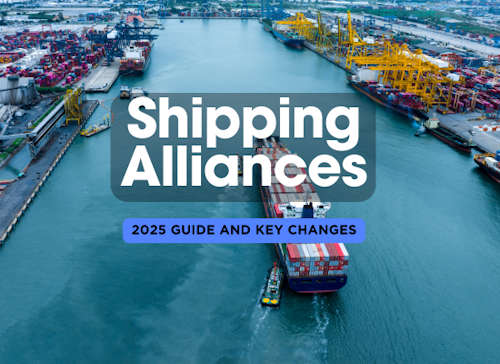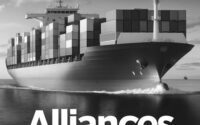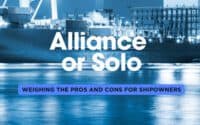Shipping Alliances 2025: Key Changes and a Deep Dive into the Global Players

The global container shipping industry will see a major reorganization as key alliances emerge to dominate the maritime landscape. These alliances will control a significant portion of global trade, ensuring efficiency, cost-effectiveness, and optimized route management across major shipping lanes. As shipping companies pool resources, share fleets, and collaborate on logistics, understanding the structure and goals of these alliances becomes crucial for industry stakeholders. This guide dives into the current alliances, exploring their members, fleet size, global coverage, and strategic ambitions as they shape the future of maritime transport.
🚢 ShipUniverse Weekly Newsletter – Free. No fluff. Just key maritime insights 📬
| ShipUniverse: Overview of Current Shipping Alliances | |||
|---|---|---|---|
| Alliance | Key Members | Fleet Size & Capacity | Coverage & Strategic Goals |
| Premier Alliance | HMM, ONE, Yang Ming | Fleet size: ~240 ships TEU capacity: 3.3 million TEUs |
Coverage: Asia-Europe, Trans-Pacific, Asia-Middle East Strategic Goals: Formed to optimize capacity and reduce operating costs in key trade routes. Focus on developing Asia-Pacific and Middle East lanes. |
| Gemini Cooperation | Maersk, Hapag-Lloyd | Fleet size: ~350 ships TEU capacity: 4.0 million TEUs |
Coverage: Global (Asia-Europe, Trans-Pacific, Trans-Atlantic) Strategic Goals: Cooperation designed to optimize major trade routes globally, reducing overcapacity while expanding service frequency. Both companies are pursuing decarbonization initiatives. |
| 2M Alliance (until 2025) | MSC, Maersk | Fleet size: ~250 ships TEU capacity: 4.1 million TEUs |
Coverage: Asia-Europe, Trans-Pacific, Trans-Atlantic Strategic Goals: Aimed at providing competitive and cost-efficient operations. The alliance is set to dissolve in 2025 as both members move toward independent operations. |
| Ocean Alliance | CMA-CGM, COSCO Group, OOCL, Evergreen | Fleet size: ~330 ships TEU capacity: 3.8 million TEUs |
Coverage: Asia-Europe, Asia-North America, Trans-Pacific Strategic Goals: To optimize operations in major east-west trade lanes, focusing on sustainable shipping practices and improving service efficiency. Extended to 2032. |
| THE Alliance (until 2025) | Hapag-Lloyd, ONE, Yang Ming, MOL, K-Line, HMM | Fleet size: ~241 ships TEU capacity: 3.3 million TEUs |
Coverage: Trans-Pacific, Asia-Europe, Trans-Atlantic Strategic Goals: Focused on enhancing capacity utilization and providing frequent services. THE Alliance is set to end in 2025, leading to the formation of the Premier Alliance. |
Key Trade Routes
Shipping alliances play a pivotal role in shaping global trade by determining how goods move across oceans via major trade routes. The alliances have carved out dominant positions on key shipping lanes, such as the Trans-Pacific, Asia-Europe, and Trans-Atlantic routes. Understanding which alliance controls which routes, along with their service frequency and major ports of call, is essential for logistics planners, port authorities, and shipping companies. This table provides a detailed breakdown of the major trade routes covered by each alliance, offering insights into their operational focus and strategic hubs.
| ShipUniverse: Major Trade Routes Covered by Each Alliance | |||
|---|---|---|---|
| Alliance | Key Regions Covered | Frequency of Service | Important Ports |
| Premier Alliance | Asia-Europe, Trans-Pacific, Asia-Middle East | Weekly services on key routes |
Asia: Shanghai, Busan, Singapore Europe: Rotterdam, Antwerp, Hamburg Middle East: Jebel Ali, Dammam |
| Gemini Cooperation | Global (Asia-Europe, Trans-Pacific, Trans-Atlantic) | High-frequency services with multiple sailings per week |
Asia: Shanghai, Ningbo, Yantian Europe: Rotterdam, Felixstowe, Antwerp North America: Los Angeles, Long Beach, New York |
| 2M Alliance (until 2025) | Asia-Europe, Trans-Pacific, Trans-Atlantic | Daily services on primary routes |
Asia: Shanghai, Shenzhen, Singapore Europe: Rotterdam, Felixstowe, Hamburg North America: New York, Long Beach, Savannah |
| Ocean Alliance | Asia-Europe, Asia-North America, Trans-Pacific | Twice weekly services on major routes |
Asia: Hong Kong, Shanghai, Busan North America: Long Beach, Los Angeles, Vancouver Europe: Rotterdam, Antwerp, Le Havre |
| THE Alliance (until 2025) | Trans-Pacific, Asia-Europe, Trans-Atlantic | Weekly services with seasonal adjustments |
Asia: Shenzhen, Hong Kong, Tokyo North America: Seattle, Los Angeles, New York Europe: Rotterdam, Hamburg, Antwerp |
The 2025 Restructuring of Global Shipping Alliances
As the maritime industry moves into 2025, a significant reshuffling of global shipping alliances is set to transform the way container shipping operates. With the dissolution of long-standing partnerships like the 2M Alliance and THE Alliance, and the formation of new alliances like the Premier Alliance and Gemini Cooperation, the industry is entering a new era. This restructuring will reshape major shipping lanes, adjust capacity, and redefine how shipping giants collaborate to optimize operations and reduce costs. The following table provides a comprehensive breakdown of the upcoming changes and the key players involved.
| ShipUniverse: 2025 Restructuring of Shipping Alliances | |||
|---|---|---|---|
| Alliance | Key Changes in 2025 | Members After Restructure | Impact on Major Trade Routes |
| Premier Alliance | Newly formed in February 2025, emerging from the reorganization of THE Alliance. | HMM, ONE, Yang Ming |
Coverage: Asia-Europe, Trans-Pacific, Asia-Middle East Impact: Increased focus on Asia-Middle East routes, enhanced capacity utilization. |
| Gemini Cooperation | Formed in January 2025, bringing together Maersk and Hapag-Lloyd after exiting 2M and THE Alliance respectively. | Maersk, Hapag-Lloyd |
Coverage: Global (Asia-Europe, Trans-Pacific, Trans-Atlantic) Impact: Stronger global coverage, more frequent services, focus on sustainability and decarbonization. |
| 2M Alliance | Dissolving in 2025 as Maersk and MSC opt for independent operations. | N/A |
Coverage: Asia-Europe, Trans-Pacific, Trans-Atlantic (until dissolution) Impact: Temporary disruptions expected on major trade routes until new independent structures are formed. |
| Ocean Alliance | Remains intact and extended until 2032, continuing its dominance on major east-west routes. | CMA CGM, COSCO Group, OOCL, Evergreen |
Coverage: Asia-Europe, Asia-North America, Trans-Pacific Impact: Continued stability and expanded services, focus on sustainability. |
| THE Alliance | Disbanding in 2025, with some members joining the Premier Alliance and others pursuing new paths. | N/A |
Coverage: Trans-Pacific, Asia-Europe, Trans-Atlantic (until dissolution) Impact: Major restructuring of services as member carriers realign with new alliances. |
#1 Premier Alliance
The Premier Alliance is set to begin operations in February 2025, marking a significant shift in the global container shipping landscape. Formed by HMM, ONE (Ocean Network Express), and Yang Ming, this alliance will emerge from the restructuring of THE Alliance, creating a leaner, more focused group that promises to enhance operational efficiency and service reliability across major trade lanes.
Key Information:
The Premier Alliance will combine the strengths of its three member companies:
- Launch Date: February 2025
- Members: HMM (South Korea), ONE (Japan), and Yang Ming (Taiwan)
- Fleet Size: Approximately 240 ships
- TEU Capacity: 3.3 million TEUs (Twenty-foot Equivalent Units)
- Primary Trade Routes: Asia-Europe, Trans-Pacific, and Asia-Middle East
The alliance's collective capacity positions it as a formidable player, with a particular focus on developing trade lanes between Asia-Pacific and the Middle East. The alliance will enhance its service offerings on these routes, ensuring efficient freight movement while cutting operating costs.
Strategic Goals:
The Premier Alliance has clearly defined strategic objectives to ensure its competitive edge:
- Optimizing Capacity Utilization: One of the primary goals is to ensure efficient use of container space across its fleet. By coordinating ship schedules and routes, the alliance reduces the number of empty slots, minimizing waste and maximizing capacity utilization.
- Cost Efficiency: By pooling resources, the Premier Alliance can reduce operational expenses, making shipping costs more competitive for customers while maintaining healthy profit margins for its member companies.
- Service Reliability: The alliance will focus on providing consistent, reliable service across its key routes. By coordinating efforts, the alliance can ensure more frequent sailings and better service continuity.
Looking Forward:
As the Premier Alliance prepares to launch, it promises to play a significant role in reshaping global trade. With its focus on cost-efficiency, route optimization, and reliable service, the Premier Alliance is well-positioned to become a dominant force in the post-2025 shipping world, particularly along the heavily trafficked Asia-Europe and Trans-Pacific routes.
By leveraging the collective strengths of its members, this alliance is expected to drive down costs for shippers while improving the overall efficiency of maritime transport across key global trade lanes.
#2 Gemini Cooperation
The Gemini Cooperation, set to launch in January 2025, will bring together two of the shipping industry's giants, Maersk and Hapag-Lloyd. This partnership will arise after both companies exit their respective alliances—Maersk from the 2M Alliance and Hapag-Lloyd from THE Alliance. With this new cooperation, Maersk and Hapag-Lloyd will combine forces to create a more flexible and globally competitive shipping network.
Key Information
The Gemini Cooperation will harness the scale and resources of two of the world's largest shipping companies:
- Launch Date: January 2025
- Members: Maersk (Denmark) and Hapag-Lloyd (Germany)
- Fleet Size: Approximately 350 ships
- TEU Capacity: 4.0 million TEUs (Twenty-foot Equivalent Units)
- Primary Trade Routes: Asia-Europe, Trans-Pacific, Trans-Atlantic
With a larger combined fleet and a wider geographical reach, this cooperation is expected to significantly improve operational efficiency and cost management for both partners.
Strategic Goals
The Gemini Cooperation is formed with specific goals that align with the future of global shipping:
- Global Network Optimization: The partnership will prioritize optimizing trade routes between Asia, Europe, and North America, where high demand and competitive pressures call for maximum efficiency.
- Decarbonization Initiatives: Both Maersk and Hapag-Lloyd have committed to reducing their carbon footprints. This cooperation will help both companies focus on lowering emissions through technological upgrades and operational changes.
- Service Frequency and Reliability: By combining their fleets, the Gemini Cooperation will be able to offer more frequent and reliable service across key global trade lanes, making it easier for customers to ship goods faster and with more predictability.
Looking Forward
The Gemini Cooperation is designed to create a stronger global presence for both Maersk and Hapag-Lloyd, enabling them to better compete in a market that increasingly values efficiency and environmental sustainability. As these two industry leaders collaborate, they will likely push forward innovations that further reduce shipping costs and environmental impact, setting new standards for the future of maritime transport.
#3 2M Alliance
The 2M Alliance, formed in 2015, has been one of the most significant partnerships in global shipping, bringing together MSC and Maersk, two of the largest container shipping companies in the world. This alliance was designed to provide cost-efficient and competitive services on major shipping routes. However, the 2M Alliance will come to an end in 2025, as both companies shift toward independent operations.
Key Information
The 2M Alliance has played a vital role in the shipping industry over the last decade:
- Launch Date: 2015
- Members: MSC (Switzerland) and Maersk (Denmark)
- Fleet Size: Approximately 250 ships
- TEU Capacity: 4.1 million TEUs (Twenty-foot Equivalent Units)
- Primary Trade Routes: Asia-Europe, Trans-Pacific, Trans-Atlantic
As one of the largest shipping alliances, the 2M Alliance has been crucial in optimizing shipping routes and reducing operational costs for both companies.
Strategic Goals
The 2M Alliance was formed with clear objectives to dominate global shipping routes and provide efficient service:
- Cost Efficiency: By sharing vessels and routes, MSC and Maersk reduced their operating costs significantly, allowing both companies to remain competitive in the global shipping market.
- Capacity Optimization: The alliance ensured that ships were fully utilized, minimizing empty container slots and maximizing profit margins on each voyage.
- Global Coverage: The 2M Alliance has been a key player on major routes such as Asia-Europe and the Trans-Pacific, helping both MSC and Maersk maintain a strong presence in critical global markets.
Looking Forward
Although the 2M Alliance will dissolve in 2025, both MSC and Maersk are expected to pursue independent strategies that could further shape the global shipping industry. MSC, the world’s largest container shipping company, is likely to operate on its own, while Maersk is set to enter the Gemini Cooperation with Hapag-Lloyd. The end of 2M marks a significant shift, but the legacy of the alliance in optimizing costs and capacity will continue to influence the strategies of both companies.
#4 Ocean Alliance
The Ocean Alliance, formed in 2017, is one of the largest and most powerful shipping alliances in the world. Bringing together CMA CGM, COSCO Group, OOCL, and Evergreen, the Ocean Alliance has extended its cooperation until 2032, ensuring long-term stability in global trade. It is known for its vast fleet and its dominance on key trade routes, particularly between Asia, Europe, and North America.
Key Information
The Ocean Alliance has cemented its place as a dominant player in global shipping:
- Launch Date: 2017
- Members: CMA CGM (France), COSCO Group (China), OOCL (Hong Kong), Evergreen (Taiwan)
- Fleet Size: Approximately 330 ships
- TEU Capacity: 3.8 million TEUs (Twenty-foot Equivalent Units)
- Primary Trade Routes: Asia-Europe, Asia-North America, Trans-Pacific
The alliance handles a significant portion of global container traffic and is a key player in the East-West trade lanes.
Strategic Goals
The Ocean Alliance focuses on long-term stability and efficiency, with several key goals:
- Service Efficiency: The Ocean Alliance aims to provide efficient, frequent services along its major trade routes, optimizing shipping schedules to reduce delays and improve reliability.
- Sustainability and Innovation: Members of the alliance, particularly CMA CGM, have placed a strong emphasis on reducing carbon emissions and investing in greener shipping technologies. This is part of a broader industry-wide push toward decarbonization.
- Global Market Penetration: By pooling resources, the Ocean Alliance has strengthened its presence in key markets across Asia, Europe, and North America, maintaining a competitive edge in global trade.
Looking Forward
The Ocean Alliance has extended its operations until 2032, making it a stable and influential player in global shipping for the foreseeable future. With a focus on sustainability and improving operational efficiency, this alliance will continue to play a pivotal role in shaping global trade flows. The strategic partnership between these four major carriers ensures that the Ocean Alliance remains a powerhouse in the container shipping industry, adapting to new challenges and opportunities as the industry evolves.
#5 THE Alliance
THE Alliance, established in 2017, is a significant player in the container shipping industry, bringing together some of the world’s leading carriers, including Hapag-Lloyd, Ocean Network Express (ONE), Yang Ming, MOL, K-Line, and HMM. However, with the restructuring of global shipping alliances set for 2025, THE Alliance will disband, with some members forming the Premier Alliance, while others pursue independent operations or new partnerships.
Key Information
THE Alliance has been a key driver of efficient shipping operations since its inception:
- Launch Date: 2017
- Members: Hapag-Lloyd (Germany), ONE (Japan), Yang Ming (Taiwan), MOL (Japan), K-Line (Japan), HMM (South Korea)
- Fleet Size: Approximately 241 ships
- TEU Capacity: 3.3 million TEUs (Twenty-foot Equivalent Units)
- Primary Trade Routes: Trans-Pacific, Asia-Europe, Trans-Atlantic
THE Alliance has provided reliable and frequent services across key global trade routes, playing a critical role in the East-West shipping corridors.
Strategic Goals
THE Alliance was formed with specific goals to maximize operational efficiency and capacity:
- Capacity Utilization: By pooling vessels and optimizing schedules, THE Alliance focused on maximizing fleet capacity, reducing the number of underutilized vessels, and providing consistent service on major shipping routes.
- Service Reliability: One of THE Alliance’s core objectives was to offer reliable, frequent services that could meet the growing demands of global trade. This was particularly important for time-sensitive shipping routes like the Trans-Pacific and Asia-Europe corridors.
- Adaptability to Market Conditions: THE Alliance members regularly adjusted their services to meet changing market demands, including adjusting fleet sizes and service frequencies to match fluctuations in trade volume.
Looking Forward
THE Alliance will disband in 2025, with several of its members set to form the Premier Alliance (HMM, ONE, and Yang Ming), while Hapag-Lloyd will join the Gemini Cooperation with Maersk. The end of THE Alliance marks a significant change in the global shipping landscape, but its legacy of operational efficiency and reliable service will continue to influence future alliances and independent operations. As members move into new partnerships, the dissolution of THE Alliance will pave the way for new collaborations and competitive strategies in the maritime industry.

Do you have a Maritime Product or Service that may be of interest to Shipowners? Tell us about it here!
Do you have feedback or insights? Please reach out to editor @ shipuniverse.com



